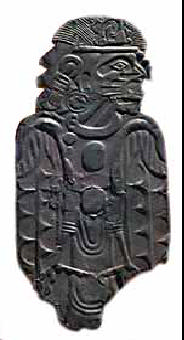
Prehistoric Native American Lesson Plan:
Our Feathered Friends: Falcon Dancer Mask
Illinois State Museum Web site used: Museumlink Prehistoric Native American https://
www.museum.state.il.us/muslink/nat_amer/pre/index.html
Falcon Dancer Exhibit in Museumlink Behind the Scenes. https://www.museum.state.il.us/muslink/
behind/htmls/exh_fal.html
Marie Murphy Jr. High School's Museum in the Classroom project on the meaning of birds in Mississip-
pian culture. https://www.avoca.k12.il.us/mariemurphy/moundbuilders/moundbuilders.html
Objective: After reading over the above Web sites and doing this activity, students will be able to
discuss what is known about the relationships the Mississippian people had with birds and why images
of birds appeared on their artifacts.
Time Required: one computer session(30+ minutes) and one art session of about 30-40 minutes.
Grade Level: 3-6
Materials:
·
printout of falcon dancer mask pattern onto card stock or traced around by students as a
stencil onto card stock.
·
markers, construction paper, colored tissue paper, and feathers with which to decorate the
mask
·
scissors
·
hole punches
·
glue
·
tape
·
string
Motivation: The design of this mask is taken from a
figure that was recreated from research on the Cahokia
site. Online, students can find many bird figures incorpo-
rated into the design of Native American artifacts, such as
pipes, potter y, and gorgets. Read and discuss the contents
of the introductory text below about the symbolism of
birds. This project reinforces the idea of the importance of
the peregrine falcon to Mississippians, as seen in their
body decoration and regalia.
Prehistoric Native American Activity : Falcon Mask --page 1 of 4
Introduction
American Indians believed that animals guided humans through life here on earth, and in the spirit
world of their beliefs. Many legends tell of ways in which animals protected, healed, taught, created,
and sometimes even tricked people. Indian people are often named after animals, and some have lived
in clans associated with an animal leader.
In many Native American cultures, birds are regarded as special messengers from the spirit world.
Because birds can fl y, it has been believed thay can carry prayers to sky spirits and return to the earth
bearing blessings and guidance. Artifacts made from the parts of birds and incorporating bird imagery
were often used as objects of spiritual powers in special rituals. Birds of particular importance to Indian
people include eagles, hawks, woodpeckers, owls, and ducks.
Eagles and hawks, both birds of pre y, are often associated with warriors and hunters. In the Mississip-
pian culture of 1000 years ago, warriors often wore feather capes and masks with beaks or painted eye
patterning of the peregrine falcon (a type of hawk) on their faces for special ceremonies. Warriors
wanted to have the characteristics of birds of prey. Wearing these costumes paid tribute to these birds.
Many Indians believed that eagles and hawks were connected to such elemental forces such as rain,
wind, thunder, and lightning. These `thunderbirds' or `thunderers' had special power in the upper world
and in this world.
The woodpecker is another bird of importance to many Indian groups. it is
considered a sacred bird because of its fire-colored head feathers, which were
associated with the sun -- a life-sustaining element. Among the Creek, Semi-
nole, and Cherokee tribes the scalps of woodpeckers were associated with
warfare. Woodpecker feathers were used in prehistoric and historic times in the
design of important ceremonial objects and regalia. Woodpecker symbolism has
been found carved on shell gorgets from the Mississippian culture and may
represent an elite group. In working with ornithologists (scientists who study
birds), archaeologists have suggested that it was the largest of all woodpeckers,
the ivory-billed or pileated woodpeckers, that were represented in prehistoric
art.
At Dickson Mounds and other burial sites, many ceramic bowls buried with the dead were made in the
shape of ducks. These effigy (in the shape of an animal) pots may have been intended to invoke the
spirit of the duck on a journey to the spirit world, reflecting the duck's ability to live in the air and the
water.
Prehistoric Native American Activity: Falcon Mask --page 2 of 4
Procedure:
Cut out the mask and beak forms.
Cut out the eye holes and punch holes at the markings on each side of the eyes.
Decorate the mask and beak forms with markers, paper, feathers, etc.
Fold the beak in half lengthwise. Tape the curved tip of the beak together on the inside.
Attach the back of the beak to the lower triangular part of the mask with tape. It will look as if the beak
is open.
Tie a string in both holes so that the mask can be worn.
Now, pretend to be a falcon dancer. (Look at Native American Dance Web sites for dance styles).
Assessment:
After viewing the appropriate Web sites and doing the activity, students can explain how birds were
symbolic to Prehistoric Illinois Native Americans, based on the knowledge we have from visual clues on
artifacts found at archaeological sites. They will name specific birds and their possible symbolism. They
should also be able to explain that these representations are possible because of research -- that the mask
pattern was taken from an artifact.
Illinois Goals and Standards addressed:
Visual Art: Goal 27: Understand the role of the arts in civilizations, past and present.
Standard B: Understand how the arts shape and reflect history, societ y, and everyday life.
Social Studies: Goal 18: Understand social systems.
Standard A: Compare characteristics of culture as reflected in the arts and traditions.
Resources:
Dickson Mounds Museum. "Reflections on Three Worlds." Cosmology mural and multimedia program,
Lewistown, Illinois. 1994.
Editors of Time-Life Books. The Spirit Worlds. Alexandria, Virginia, 1992.
Erdoes, Richard and Ortiz, Alfonso, eds. American Indian Myths and Legends. Pantheon Books, New
York, 1984.
Hudson, Charles. The Southeastern Indians. University of Tennessee Press, 1978.
Spence, Lewis. Native American Myths and Legends. Long Meadow Press, Stanford, Connecticut, 1993.
Prehistoric Native American Activity: Falcon Mask --page 3 of 4
Prehistoric Native American Activity: Falcon Mask --page 4 of 4
